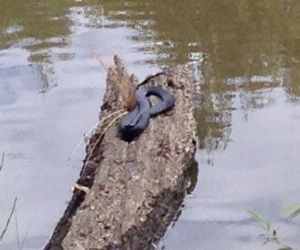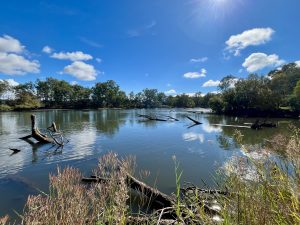By all accounts it has been a great season for snakes, with many sightings coming in from local parks and reserves. Reports of brown, black and tiger snakes are most common locally.
Snakes play an important role in our local ecosystems and perform the great service of keeping the rodent population down where we humans create the perfect environment for them.
It is in all of our interests to forbear when encountering a snake; they will always depart if given the chance, they are protected by law and of course, they carry their own very effective protection!
Red-bellied black snake (Psuedechis porphyriacus)
Commonly seen close to dams, creeks and other bodies of water, this snake is easily identified by its unvarying colouring; glossy black with a light pink to brilliant red belly.
The red bellied black snake is most active by day. When not hunting or basking it retires beneath timber, rocks and rubbish or down holes. It’s diet is primarily frogs, but it also preys on reptiles, small mammals and the young of other snakes.
Although dangerously venomous, bites are rare from this placid and fairly docile snake. If provoked, it will enact a lengthy bluff display with hisses and flattened neck, then try to escape at the first opportunity. The bite of a red-bellied black snake is rarely life-threatening as they usually inject little toxin, however a bite still requires immediate medical attention.
Eastern brown or Common brown snake (Pseudonaja textilis)
The brown snake has a slender body and variable colour ranging from uniform tan to grey or dark brown. Some young brown snakes have stripes and are often confused with tiger snakes. A large adult brown snake may exceed two metres in length.
Brown snakes are active during the day, hunting for small mammals, particularly rodents. They will also eat frogs, small birds, eggs, and even other snakes. Because of their preference for introduced rats and mice brown snakes are often found around human habitation.
Browns are notorious for their speed and aggression. When highly agitated, they hold their necks high, appearing in an upright S-shape. The snake usually tries to flee when confronted, though it can be highly defensive if provoked.
The brown snake is by far the most common cause of snakebite in our area. Their venom causes diarrhea, dizziness, collapse or convulsions, renal failure, paralysis and cardiac rest. Without medical treatment, bites can be fatal.
Tiger snake or Mainland Tiger snake (Notechis scutatus)
Tiger snakes are highly variable in appearance, not always displaying the distinctive tiger stripes suggested by its name. The body can also be grey, olive-brown or almost black. Tiger snakes are relatively short and stout bodied with a broad head. Commonly 1.2-1.6m in length, particularly large animals may exceed 2m.
Tiger snakes are common near swamps, wetlands and water courses, as frogs are their main diet. They will also eat lizards, birds, small mammals and fish. These snakes are tolerant of lower temperatures than brown and black snakes, and in hot weather often hunt at night.
Tiger snakes put on an impressive threat display before attempting to bite; flattening their body and raising their head, they hiss loudly and follow up with mock strikes.
The bite is highly venomous. Symptoms include localized pain in the foot and neck region, tingling, numbness, and sweating, followed by a fairly rapid onset of breathing difficulties and paralysis.
Treating snake bites
Treatment is the same for all Australian venomous snakes. The pressure immobilization method is used to inhibit the flow of venom through the lymphatic system. Broad, thick bandages are applied over the bite, then down and back along the limb to the armpit or groin. The affected limb is then immobilized with a splint.
Reducing snake habitat around your home
Control vermin around poultry sheds, compost bins and buildings. Clear ground shelter like old tin and rubbish from the yard. Snakes are attracted by water put out for pets, so maintain an alternative water source for them away from the house.
Removing snakes
Parklands rangers do not remove snakes. Local contractors are available, including:
Tristan Hamilton – 0431 530 057
Noel Crossman from Pest Control – 0412 576 541
Chris Porter – 0432 175 513






